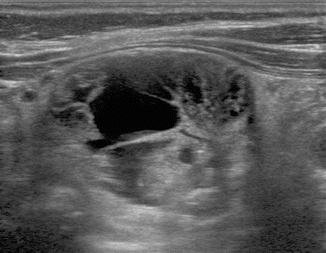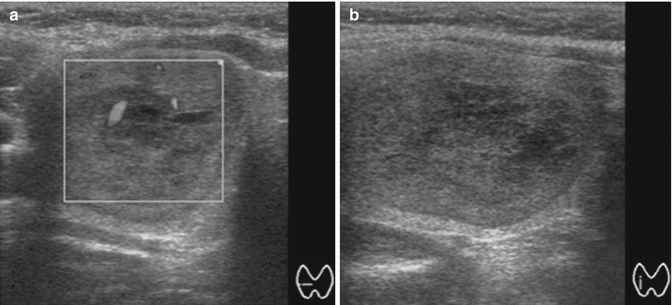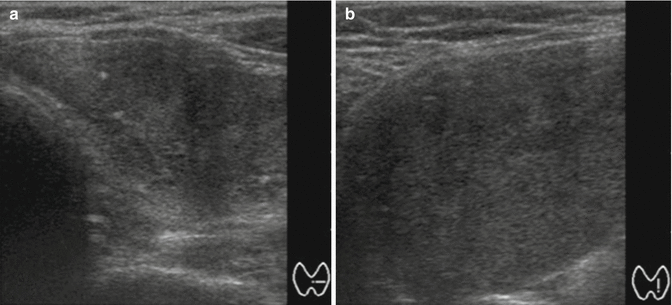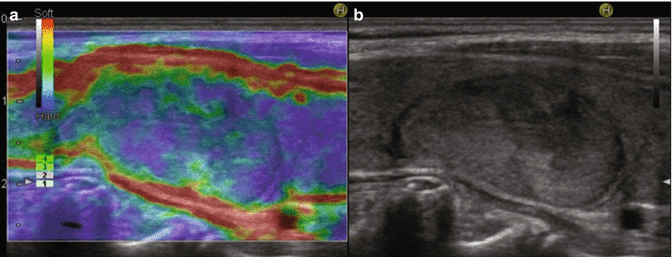Fig. 9.1
A papillary thyroid carcinoma (PTC) in the isthmus (transverse scan). The cancer appears as an iso-hypoechoic lesion, infiltrating the thyroid capsule and invading the adjacent muscles. The lesion presents irregular spiculated edges and its echostructure is inhomogeneous for microcalcifications
9.4 Internal Content
A thyroid nodule can be: solid (liquid portion ≤10 % of the nodule volume), mixed predominantly solid (liquid portion between 10 % and ≤50 % of the nodule volume), mixed predominantly cystic (liquid portion >50 % but ≤90 % of the nodule volume) (Fig. 9.2), cystic (liquid portion >90 % of the nodule volume), and spongiform (nodule characterized by aggregation of multiple microcystic areas <5 mm separated by thin septations that are interspersed within solid tissue) (Fig. 9.3). Generally, cystic lesions are always benign. Mixed polyconcamerated cysts, instead, may harbor a risk of malignancy. The spongiform pattern is usually associated to benignancy, but globally, the internal content does not give certainty about the nature of a thyroid lesion.



Fig. 9.2
A mixed thyroid nodule in the right lobe (longitudinal scan). This oval lesion is mainly liquid but presents an isoechoic solid component with septa, conferring a typical heterogeneous appearance

Fig. 9.3
A large ovoid spongiform nodule of the right thyroid lobe, transverse (a) and longitudinal (b) sections. The lesion is hypoechoic and finely heterogeneous and presents regular and well-defined margins
9.5 Shape
Thyroid nodules can be: ovoid (anteroposterior diameter less than its transverse diameter) (Fig. 9.3), round (anteroposterior diameter equal to transverse diameter), taller-than-wide (anteroposterior diameter longer than transverse diameter), and irregular (nodule neither ovoid/round nor taller-than-wide). Ovoid and round shapes may be present in both benign and malignant lesions. A taller-than-wide shape, instead, is reported to be more strongly associated with thyroid malignancy [4].
9.6 Echogenicity
A thyroid lesion can be: markedly hypoechoic (hypoechoic relative to the adjacent strap muscles), hypoechoic (hypoechoic relative to the thyroid parenchyma) (Fig. 9.3), isoechoic (the same echogenicity of the thyroid parenchyma), hyperechoic (more echoic than thyroid parenchyma), and anechoic (in cystic lesions). Pure anechoic cysts are usually benign. Isoechoic or hyperechoic nodules are often benign lesions. Hypoechogenicity is frequently reported in thyroid malignancies but unfortunately is also reported in almost a third of benign thyroid lesions. A marked hypoechogenicity, instead, seems to be more specific for malignancy [5].
9.7 Echotexture
A nodule can be homogeneous, finely inhomogeneous (Fig. 9.3), or markedly inhomogeneous (Fig. 9.1). Malignancy cannot be excluded in homogeneous lesions, and, similarly, the heterogeneous echotexture is not exclusive of malignancies. It follows that the echotexture cannot be considered a useful tool in distinguishing malignant from benign lesions [6].
9.8 Calcifications
Calcifications can be classified as microcalcifications, macrocalcifications, and peripheral rim calcifications (eggshell calcifications). Microcalcifications appear as small (<1 mm) intranodular punctate hyperechoic spots without posterior acoustic shadowing (Fig. 9.1) and are highly suggestive of papillary thyroid cancer. Macrocalcifications are coarse and large calcifications (>1 mm) with posterior acoustic shadowing most frequently occurring in old degenerating nodules. Peripheral rim calcifications surround the thyroid lesion and are usually thought to indicate a benign nodule. However, in case of an interruption of the rim calcification, the possibility of cancer should be considered.
9.9 Margins
The definition of nodules’ margins is highly operator-dependent. Nevertheless, the edges of a thyroid nodule may be described as: well-defined (when there is a clear demarcation with normal thyroid tissue) (Fig. 9.4) or ill-defined (lack of clear demarcation with normal thyroid parenchyma) (Fig. 9.1) and regular (without irregularities and imperfections) (Fig. 9.3) or irregular (with edges and irregularities), the latter further divided into spiculated (presence of one or more spiculations on its surface) (Fig. 9.1) and microlobulated (presence of one or more smooth lobules on its surface). Ill-defined and irregular, both spiculated and microlobulated, margins are usually reported to be suggestive of malignancy [5].


Fig. 9.4
A large solid nodule in the left thyroid lobe, transverse (a) and longitudinal (b) sections. The lesion is hypoechoic and heterogeneous, presents regular edges, and deforms the thyroid capsule without interrupting its hyperechogenicity
The halo sign, a hypo-anechoic ring that may completely or incompletely surround a nodule, can be a regular thin halo (Fig. 9.5) or an irregular thick halo. The first is usually suggestive of benignancy [7, 8]; the latter, instead, may also represent the fibrous capsule surrounding a neoplastic growth.






Fig. 9.5
Qualitative elastography (USE) of a solid, isoechoic thyroid nodule with thin hypoechoic halo (longitudinal scans). The USE technique combines anatomic B-mode (b) and elasticity images (a). The elastogram is displayed over the B-mode image in a color scale depending on the magnitude of strain, usually red (soft tissue), green (intermediate degree of stiffness), and blue (hard, inelastic tissue). The nodule in the figure, appearing mainly blue at elastographic evaluation, is classified as a hard lesion
< div class='tao-gold-member'>
Only gold members can continue reading. Log In or Register to continue
Stay updated, free articles. Join our Telegram channel

Full access? Get Clinical Tree


